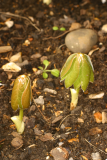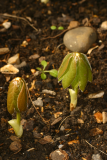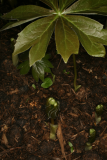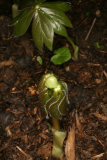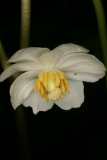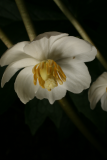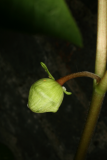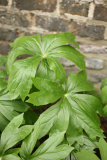Additional notes (click to expand)
Medicinal
Topoisomerase inhibitors. Contain podophyllotoxin for treating genital warts. Synthesised to etoposide for testicular and lung cancers, and acute leukaemias; teniposide for leukaemias and Hodgkin’s lymphoma.
Oakeley, Dr. H.F. (2013). Medicines from RCP plants label list 5-2013.docx.
POM – podophylotoxin, etoposide, teniposide
Nomenclature
hybridparent of: Berberidaceae Podophyllum × inexpectatum J.M.H.Shaw in New Plantsman, 6(3): 159 (1999).
Other Common: MAY APPLE; ;BEHEN;DEVIL'S APPLE;DUCK'S FOOT;GROUND LEMON;HOG APPLE;INDIAN APPLE;INDIAN MAY APPLE;PECA;RACCOON BERRY;WILD JALAP;WILD LEMON TREE;WILD MANDRAKE
Other use
This North American plant has pretty fl owers followed by little berries hiding under its leaves. Lindley describes the rhizome as being a ‘very sure and active cathartic [a purgative]’, but that the leaves are poisonous and the whole plant narcotic. Austin reports that the ripe fruits were eaten by the Cherokee, Ojibwa, Iroquis and others, but that the roots are highly poisonous and were eaten to commit suicide, and in smaller doses as a purgative. Extracts from the roots were used by the Cherokee to treat intestinal worms – in a dose which was more poisonous to the latter than the patient. The Menomini used it as an insecticide and the Penobscot to cure warts. It is reported erroneously that this latter cytotoxic action was noted by Robert Bentley in 1861 at King’s College and a poultice from the roots was, for a while, used to treat cancers that had broken through the skin, however the plant so noted by Bentley was Sanguinaria canadensis. An extract of the roots, podophyllin, is still used to treat venereal warts, and the semi-synthetic derivatives etoposide and teniposide, valuable treatments for various cancers, have been produced from it.
Oakeley, Dr. Henry. (2011). A Year in the Medicinal Garden of the Royal College of Physicians, revised edition. Royal College of Physicians, London. page 23
link
Notes by Henry Oakeley from Lindley's 'Flora Medica' (1838): The ‘May Apple’ of the United States (where it is also called ‘Mandrake’ though that name is usually used for Mandragora officinalis of Europe) is to be found coming into leaf in April, and into flower in May, in the North American beds to the right of the exit from the College car park. Lindley describes the rhizome as being a ‘very sure and active cathartic [a purgative]’, but that the leaves are poisonous and the whole plant narcotic. He makes no note of its topical use in treating venereal warts for which it is used in modern medicine as podophyllum and podophyllotoxin (see British National Formulary), extracted from the rhizome. Even when applied topically, care must be taken as it is absorbed readily and can produce toxic side effects.
Lindley, John. (1838). Flora Medica, Longman, Orme, Brown, Green & Longmans
Toxicity
"Humans/Pets: Harmful if eaten"- HTA guidelines
HTA Guide to Potentially Harmful Plants, 3rd Edition (2022)
Highly toxic if ingested or the skin is contaminated causing severe vomiting and brain damage. It is genotoxic.
Professor Anthony Dayan, 2022
Geographical distribution
- Northern America, Northeastern U.S.A.
Podophyllum peltatum L.
Family: BERBERIDACEAEGenus: Podophyllum
Species: peltatum L.
Common names: American Mandrake
Distribution summary: E. N. America
Habit: Perennial
Hardiness: H5 - Hardy; cold winter
Garden status: Currently grown
Garden location: North America (A), North America (A)
Reason for growing: Medicinal, toxic, prescription only medicine
.jpg)
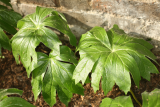
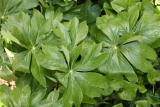
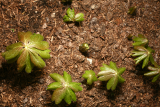
.jpg)
.jpg)
.jpg)
.jpg)
